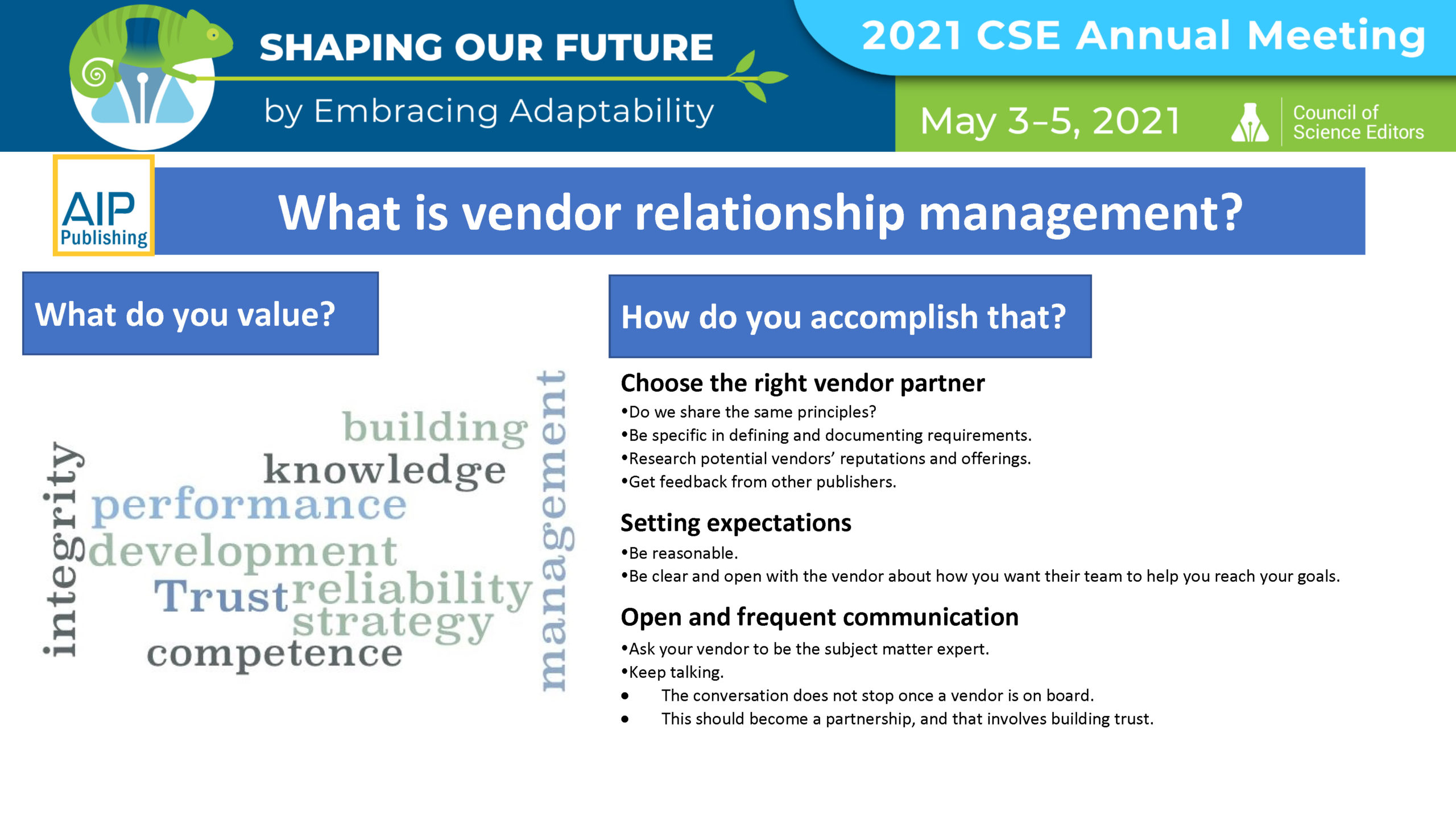MODERATOR:
Heather DiAngelis
American Society of Civil Engineers
Reston, Virginia
SPEAKERS:
Theresa Fucito
AIP Publishing
Melville, New York
Byron Laws
Nova Techset – Katalyst
Susan D Willner
American Society of Nephrology
Arlington, Virginia
REPORTER:
Samantha Bruno Fuller
American Association for the Advancement of Science
Washington, DC
Production vendors play a key role in the success of many publishers and their journals. They provide services and technologies that can greatly increase the quality and reach of a publication. Introducing vendors into the equation of publication management is common but requires management of the vendor relationship. This is not always easy, and this session explored the relationship from both the vendor and customer perspectives, providing guidance on how to improve the relationship and thus, your publication.
Theresa Fucito, Director, Content Operations at AIP Publishing, started off the session from the customer perspective. She spoke about AIP’s recent launch of a new books program and how they were reliant on the production vendor to make it a success. She outlined tips for managing this relationship, starting with vendor selection. Customers need to have a clear understanding of what priorities and attributes they value and choose a vendor that echoes those. Once you enter into a vendor relationship, trust needs to be built. The vendor–client relationship should be a partnership with constant communication to set expectations, ensuring everyone is on the same page, and monitoring the progress of projects.

A feedback loop should be established; however, keep in mind that feedback in the form of email should be constructive. Be professional in your correspondence and be specific but concise in your description of any issues. Positive feedback and acknowledgement of success are a sure way to improve the relationship. So, don’t reserve your vendor communication solely for problems.
Byron Laws, Sales Director, Americas at Nova Techset – Katalyst continued the session from the viewpoint of the vendor. The services his company provides are technology-based, and Byron serves in an intermediary role between author, publisher, and vendor. He acts as a mediator, advocate, troubleshooter, and cultural interpreter, often coaching his colleagues to acknowledge errors. This provides customers with transparency and confidence in the vendor.
Communication and transparency are crucial for a vendor relationship to flourish. Vendors need to be clear about what they can offer a customer so that there are no surprises once a contract is signed and projects commence. Customers also need to be very clear and consistent about what they want to help vendors address and anticipate their needs. On both sides, there should be a willingness to compromise where appropriate as well. When it comes to feedback, don’t put off having difficult conversations. Be upfront about issues you’re noticing so they can be addressed quickly.
When you are researching vendors to see if they are the best fit for your product, consider their previous work. Ask for samples and also for their expertise. Present your problem and ask the vendors for their solution; they may have one you didn’t think about before. Customers also need to be mindful that vendors need to make money, and customers should want vendors to be successful because this will help advance their product in the future. We’re always looking for the best price but should also keep quality in mind. In most cases, you get what you pay for.
Susan Willner, Publications Manager, American Society of Nephrology, wrapped up the session with more guidance from the customer perspective. She started off her presentation with the sentiment that vendors are an extension of your office. The best way to communicate with them is to have a common language, making sure the terms you use are clearly defined at the onset of your relationship because they could have a different meaning for the vendor. Educate your staff about the vendor and vice versa. Project proposals are never perfect the first time, but you can do things to help. Point to examples of what you want, helping the vendor avoid having to reinvent the wheel. Tell them why you’re doing something and what your end goal is. Providing annotated mockups can also be extremely helpful in communicating your needs.
When embarking on a new project, ensure that there aren’t too many cooks in the kitchen. A project team should be designated to avoid conflicting feedback and information that could result in an elongated process and errors. Have a clear plan in place with a schedule of deliverables and deadlines. Don’t shy away from communicating issues—the sooner they are brought to light, the sooner they can be addressed. If you are open and honest with a vendor, ask them to do the same with you. Don’t hesitate to keep asking “what else?” The more questions you ask and have answered, the more likely you will be satisfied with the finished product.
All three presenters had various views and tips, but one theme resonated—communication. In any relationship, communication is of the utmost importance and client–vendor relationships are no different. The presentations had extremely useful advice for improving relationships and ultimately achieving better product implementation and customer satisfaction.
